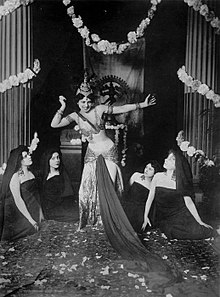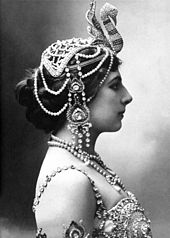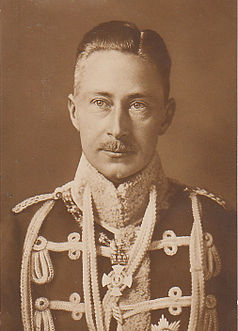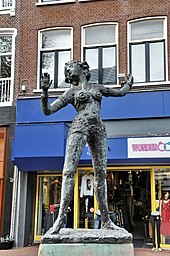
Mata Hari - 1906
Born to Adam Zelle and his first wife, Antje van der Meulen, in Leeuwarden, Netherlands, on August 7, 1876, eldest child Margaretha (three brothers will follow) grows up leading a pampered early life thanks to the earnings of her father's hat shop and his investments in the oil industry. Things change though when she is thirteen and in a series of hammer blows between 1889 and 1893, her father goes bankrupt, her parents divorce, her mother dies, and her father remarries. Family broken, Margaretha is sent off to live with her godfather and begins studying to become a kindergarten teacher ... a career that comes to an abrupt end when the school's headmaster grows too charmed by the teenager's nubile figure and she is yanked from the institution by her irate custodian. Her next stop is her uncle's home in The Hague, but not for long. At eighteen, in an age when sight unseen arranged marriages are quite common, Margaretha answers an advertisement in a Dutch paper and is soon off to the Dutch East Indies (now Indonesia) where she becomes the wife of thirty-nine-year-old Dutch Colonial Army Captain Rudolf MacLeod.
Margaretha & MacLeod
Married to the son of a Dutch baroness and the Scottish Isle of Skye Clan MacLeod, Margaretha instantly becomes a member of the Dutch upper class and bears her husband a son, Norman-John (1897) and a daughter, Louise Jean (1898). Enabled once more too enjoy the good things in life, Margaretha soon discovers why MacLeod has had to advertise for a wife ... her husband is an alcoholic, wife beater, blames his wife for his failures to be promoted, and is extremely unfaithful, openly keeping a concubine and contracting syphilis (which is said to have killed his young son in 1899). Caught in a loveless marriage, Margaretha throws herself into studying the local customs and joins a local dance company where she begins calling herself Mata Hari, Malay for the "Eye of the Day." Pressure building to part, the couple and their daughter move back to the Netherlands, where they separate in 1902 and then divorce in 1906 (MacLeod takes over custody of their daughter by failing to pay Margaretha the child support the court's have found she is entitled).

MacLeod And Son

Louise
Reinventing herself once more, Margaretha moves to Paris, and to earn a living, takes jobs as a circus horse rider, artist's model, and an exotic dancer. Using lessons learned in Java mixed with flaunting her body (she progressively sheds clothing until she is in nothing but a bejeweled bra and nude colored body stocking) and flirting with her audience, to growing fame as Mata Hari (she pretends to be a Javanese princess born into the sacred dances of the Hindu), Margaretha gains the talents of French theatrical impresario Gabriel Astruc, who books her into the Musee Guimet. A sensational hit there, she also becomes the mistress of millionaire industrialist Emile Etiene Guimet, the founder of the Musee. Firecracker hot for years, as customs change and copycat acts arise, the fickle public eventually finds our past times and pleasures for their wallets and attentions ... Margaretha's career as a dancer will go into decline after 1912, and she will perform for the public for the last time on March 13, 1915.

Gabriel Astruc

1905 Shimmy

Almost Nude - 1906

Publicity Still - 1910
Dancing ended, Margaretha though has taken care to provide for her future using her movement talents to forge a somewhat related career, that of a popular courtesan. Known for her eroticism and sensuality as Mata Hari, the free-spirited Margaretha has established relationships with millionaire industrialists, important politicians, and high ranking military officers that cross international borders ... but in the madness of a world at war, it will prove to be her undoing.

Amsterdam - 1915
Declaring itself neutral, as a citizen of the Netherlands and a former well known star, Margaretha travels across national borders freely despite the war, a habit which soon brings her to the attention of foreign espionage services interested in using that ability. In 1916, when her current lover, twenty-five-year-old Russian Captain Vadim Maslov is shot down and wounded (he will lose his sight in the encounter) while serving with the French in a dogfight over the Western Front, both sides in the conflict take advantage ... for providing information on the French military, the Germans will allow her to visit her lover at the hospital where he is recovering from his wounds, while for monetary gains, the French wish her to enlarge her relationship with the eldest son of Germany's Kaiser Wilhelm II, Crown Prince Wilhelm (Friedrich Wilheim Victor August Ernst). Foolishly thinking she is in control of the situation, Margaretha agrees to both proposals. Untrained in the nuances of espionage, she provides little information to either side beyond what could already be found in the society and gossip sections of the era's newspapers and soon is identified as a spy by both sides ... a very disposable spy (she will be labeled H-21 by German intelligence).

The Crown Prince
Seeking a scapegoat to keep the public's attention off the bad war news and recent mutiny by part of the French Army, the French War Ministry allows Margaretha to obtain the names of six Belgian agents the French believe are working for the Germans. Seeds sown and then reaped, when the names are communicated to the German side, French authorities sweep in and arrest "Mata Hari" in Paris room at the Hotel Elysee Palace on February 13, 1917 (she is placed in isolation in a flea and rat infested cell of the woman;s prison at Saint-Lazere, given no soap for washing, and denied access to medial treatment, clean clothing and lingerie, and allowed only marginal access to her lawyer). Brought to trial, Margaretha is defended by the renowned Edouard Clunet, but the veteran lawyer is up against a stacked deck ... letters to the Dutch ambassador are ignored, her lover, Maslov refuses to testify on her behalf, claims are made that information she has provided to the Germans has led to the deaths of 50,000 Allied soldiers, evidence is tampered with, questioning of several witnesses is denied, evidence is doctored, her morals are questioned and lead prosecutor Captain Pierre Bouchardon (later he will admit,that there wasn't enough evidence in the case "to flog a cat in the case.") is even allowed to state, "Without scruples, accustomed to making use of men, she is the type of woman who is born to be a spy." Professing she is loyal to France and only provided gossip to the Germans so she could see her lover, few in France are surprised when she is found guilty of being a spy by seven male members of the French military and sentenced to death by a firing squad.

At The Time Of Her Arrest

Bouchardon
Attempts to commute the sentence to a prison term squashed, presidential pardon denied, three months after her trial the "Grand Spy" is brought from her cell on October 15, 1917, and in front of witnesses that include her lawyer, the nuns who have looked after her, the prison doctor, British reporter Henry Wales, and her executioners (a young squad of twelve soldiers of the Fourth Regiment of Zouaves in khaki uniforms and red fezzes, supervised by a sergeant major of the 23rd Dragoons), gives a goodbye performance worthy of the legend she is about to become. Unbound, wearing a tailored suit and new white gloves, Margaretha refuses a blindfold, and a moment before being shot, blows a kiss to her killers. Volley taken, she slowly settles to her knees with her head up and no change on the expression her face is wearing, gazing at the men who have taken her life, before falling backwards at the waist, her legs doubled up beneath her ... a posture where she receives a bullet to the brain to make sure she is dead from the sergeant major, who will afterwards opine, "By God! This lady knows how to die."

Execution
And though dead, Margaretha's story continues. Body unclaimed by any family members, her corpse is given to the Museum of Anatomy in Paris ... where sometime between 1954 (when the establishment is relocated) and 2000 it vanishes, and remains lost to the present. The Fries Museum of Leeuwarden, Netherlands has a "Mata Hari Room" containing Magaretha's personal scrapbooks and other memorabilia, and the building of her birthplace, where her father once ran a hat shop, is a historic site the includes an information center and more mementos, and is fronted by a statue of the woman. Along with numerous books, to date, there have been five stage musicals and an opera written about her life. The archetype of the classic femme fatale, on the silver screen she has been portrayed by Magda Sonja (1927), Greta Garbo (1931), Jeanne Moreau (1964), and Sylvia Kristel (1985), along with being the subject of a comic book. Even the children's spy series of 1970s television, Lancelot Link, Secret Chimp pays tribute to Margaretha, naming its female spy chimp, Mata Hairi.

Statue

Garbo As Mata Hari
Gone over a hundred years now ... Margaretha is far from being forgotten!
Margaretha Geertruda MacLeod Zelle aka Mata Hari
No comments:
Post a Comment